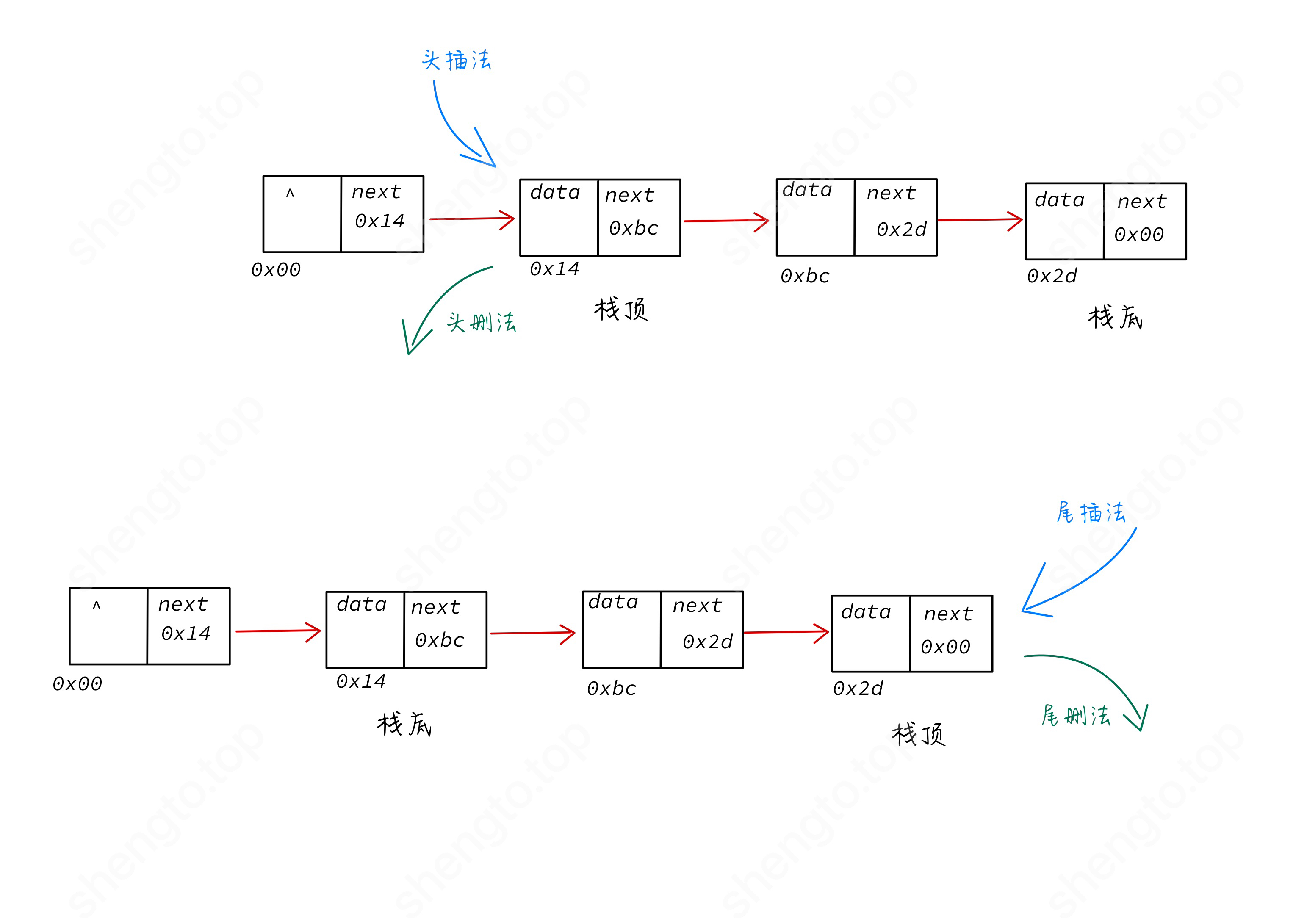链栈
借助单向链表,插入和删除操作若均在表头进行(头插和头删),则表尾为栈底;反之,若插入和删除操作均在表尾进行(尾插和尾删),则表头为栈底。

链栈的结构体声明
typedef struct stackLink{
data_t data;
struct stackLink* next;
}STACKLink,*StackLink;链栈的操作
基本操作:创建、入栈(单端插入)、出栈(单端删除)、遍历(打印)等。
创建一个链栈
StackLink create()
{
StackLink h = (StackLink)malloc(sizeof(STACKLink));
h->next = NULL;
memset(&(h->data),0,sizeof(data_t));
return h;
}创建一个数据结点
StackLink createNode(data_t val)
{
StackLink node = (StackLink)malloc(sizeof(STACKLink));
node->next = NULL;
node->data = val;
return node;
}判空
int isEmpty(StackLink h)
{
return h->next==NULL?1:0;
}入栈(头插法插入)
void headInsert(StackLink h,data_t val)
{
StackLink node = createNode(val);
node->next = h->next;
h->next = node;
}出栈(头删法删除)
void headDelet(StackLink h)
{
if(isEmpty(h))
{
printf("栈空\n");
return;
}
StackLink temp = h->next;
h->next = temp->next;
printf("出栈:%d\n",temp->data);
free(temp);
}入栈(尾插法插入)
void tailInsert(StackLink h,data_t val)
{
StackLink node = createNode(val);
StackLink temp = h;
while(temp->next!=NULL)
{
temp = temp->next;
}
temp->next = node;
}出栈(尾删法删除)
void tailDelet(StackLink h)
{
if(isEmpty(h))
{
printf("栈空\n");
return;
}
StackLink temp = h;
StackLink tail = temp->next;
while(tail->next!=NULL)
{
temp = temp->next;
tail = tail->next;
}
temp->next = NULL;
printf("出栈:%d\n",tail->data);
free(tail);
}遍历(打印)
void printStack(StackLink h)
{
StackLink temp = h;
while(temp->next!=NULL)
{
printf("%d ",temp->next->data);
temp = temp->next;
}
putchar(10);
}示例
#include <stdio.h>
#include <stdlib.h>
#include <string.h>
typedef int data_t;
typedef struct stackLink{
data_t data;
struct stackLink* next;
}STACKLink,*StackLink;
StackLink create();
StackLink createNode(data_t val);
void printStack(StackLink h);
int isEmpty(StackLink h);
void headInsert(StackLink h,data_t val);
void headDelet(StackLink h);
void tailInsert(StackLink h,data_t val);
void tailDelet(StackLink h);
int main(int argc, const char *argv[])
{
printf("头节点为栈顶:");
StackLink hh = create();
headInsert(hh,1);
headInsert(hh,2);
headInsert(hh,3);
headInsert(hh,4);
headInsert(hh,5);
printStack(hh);
headDelet(hh);
printStack(hh);
printf("头节点为栈底:");
StackLink ht = create();
tailInsert(ht,1);
tailInsert(ht,2);
tailInsert(ht,3);
tailInsert(ht,4);
tailInsert(ht,5);
printStack(ht);
tailDelet(ht);
printStack(ht);
return 0;
}
//创建一个链式栈
StackLink create()
{
StackLink h = (StackLink)malloc(sizeof(STACKLink));
h->next = NULL;
memset(&(h->data),0,sizeof(data_t));
return h;
}
//创建一个数据节点
StackLink createNode(data_t val)
{
StackLink node = (StackLink)malloc(sizeof(STACKLink));
node->next = NULL;
node->data = val;
return node;
}
//判空
int isEmpty(StackLink h)
{
return h->next==NULL?1:0;
}
//尾插法插入 (入栈)
void tailInsert(StackLink h,data_t val)
{
StackLink node = createNode(val);
StackLink temp = h;
while(temp->next!=NULL)
{
temp = temp->next;
}
temp->next = node;
}
//头部删除(出栈)
void headDelet(StackLink h)
{
if(isEmpty(h))
{
printf("栈空\n");
return;
}
StackLink temp = h->next;
h->next = temp->next;
printf("出栈:%d\n",temp->data);
free(temp);
}
//头插法插入(入栈)
void headInsert(StackLink h,data_t val)
{
StackLink node = createNode(val);
node->next = h->next;
h->next = node;
}
//尾部删除(出栈)
void tailDelet(StackLink h)
{
if(isEmpty(h))
{
printf("栈空\n");
return;
}
StackLink temp = h;
StackLink tail = temp->next;
while(tail->next!=NULL)
{
temp = temp->next;
tail = tail->next;
}
temp->next = NULL;
printf("出栈:%d\n",tail->data);
free(tail);
}
//遍历
void printStack(StackLink h)
{
StackLink temp = h;
while(temp->next!=NULL)
{
printf("%d ",temp->next->data);
temp = temp->next;
}
putchar(10);
}结果
头节点为栈顶:5 4 3 2 1
出栈:5
4 3 2 1
头节点为栈底:1 2 3 4 5
出栈:5
1 2 3 4本文链接:https://shengto.top/data_structure/156.html
转载时须注明出处及本声明